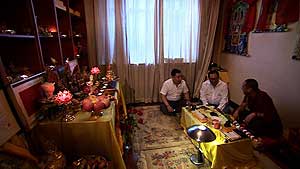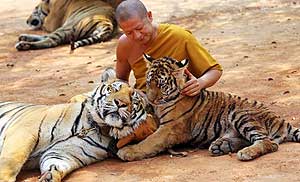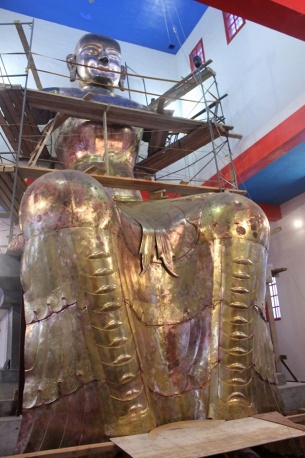By John Sudworth, BBC, 29 January 2015
Shanghai, China -- Could China be bringing Tibetan
Buddhism in from the cold? There are new signs that while a crackdown on
Tibetan nationalism continues, the atheist state may be softening its
position towards the religion - and even the Dalai Lama.
 << Xiao Wunan, a former senior Communist Party official and Geshe Sonam next to Xiao's shrine in his apartment
<< Xiao Wunan, a former senior Communist Party official and Geshe Sonam next to Xiao's shrine in his apartment
That a former senior Communist Party official would invite the BBC
into his home might, to most foreign journalists in China, seem an
unlikely prospect.
Especially if that official was rumoured to have close links to the
Chinese leadership and to have worked closely with the country's
security services.
But the idea that such an official would then invite the BBC to
witness him praying in front of a portrait of the Dalai Lama, would seem
a preposterous one. Laughable - insane even.
That, though, is exactly what Xiao Wunan did.
Inside Xiao's luxury Beijing apartment, in pride of place atop his
own private Buddhist shrine, sits a portrait of the exiled Tibetan
spiritual leader, a man long reviled by the Chinese government as a
dangerous separatist.For Tibetan monks even the possession of the Dalai Lama's photograph is a
risky proposition and the displaying of his portrait in monasteries is
prohibited.
But there, beneath that same image sat Xiao, with a Tibetan Buddhist guru, Geshe Sonam, sitting beside him.
While the guru made it clear he was unwilling to talk about politics
or the Dalai Lama, the 50-year-old Mr Xiao insisted it was really no big
deal.
"In regard to the political problems between the Dalai Lama and China… we hardly pay any attention," he says.
"It's really hard for us to judge him from that angle. As Buddhists,
we only pay attention to him as part of our Buddhist practice."
Xiao was introduced to the BBC by a Chinese businessman, 36-year-old
Sun Kejia - one of an unknown, but reportedly growing number of wealthy
Chinese, drawn in recent years to the mysticism of Tibetan Buddhism.
The increasing popularity of religion in general in China has been
well documented and is often explained in terms of China's rapid
economic expansion.
Millions of Chinese today may now have the kind of wealth that
previous generations could only dream of, but economic growth has been
accompanied by seismic social upheaval and many of the old certainties
have been swept away.
"I was once confronted with great difficulties and problems in my business," Sun says.
"I felt they couldn't be overcome by human effort and that only Buddha, ghosts and God could help me."
So Sun became a follower not of merchant bankers or money managers,
but monks - Tibetan monks in particular. And he has indeed since earned
his fortune, which he estimates at more than $100m.
He now runs a chain of Buddhist clubs, and pays from his own pocket
for Tibetan gurus like Geshe Sonam to come and preach there, giving them
badly needed funds for their missions and monasteries back in Tibet.
But while Sun's invited guests - businessmen, party officials and
property owners - find comfort and spirituality, he finds something
else.
"What I want is influence," he says.
"My friends who come here are attracted to this place. I can use the
resources they bring to do my other business. From that angle, it is
also my contribution for spreading Buddhism. This brings good karma and
so I get what I want."
And it seems to be working.
Sun invites us to meet other well-connected individuals who use his club.
Seated on the floor with Geshe Sonam is a woman who Sun says is
connected through family ties to the highest echelons of Chinese
politics.
She and a man she introduces as a senior official at China's National
Development and Reform Commission, and who appears to be her driver,
are placing watches, prayer beads and necklaces into the centre of the
circle for Geshe Sonam to bless.
A luxury banquet follows the religious ceremony, and later the monk admits to being a bit uncomfortable with the whole thing.
"No matter how good the food is, it's still just food," he says.
"Sometimes it takes so long and I really feel I'm wasting my time. I
become a bit anxious. But this can also be a way to preach. If I don't
go here, or don't go there, would it be better for me to just stay in a
cave and never come out?"
Buddhist monks need the money and dozens, perhaps hundreds, are now prospecting for funds in China's big cities.
Given that China is still, officially, an atheist country, that may
seem odd, especially because of the links between Buddhism and political
activism in Tibet.
China however is not only allowing this Buddhist evangelism to take place but may now be actively encouraging it.
There have been reports that President Xi Jinping is - relatively
speaking - more tolerant of religion than his predecessors, in the hope
that it will help fill China's moral vacuum and stem social unrest.
And there have also long been rumours that members of the Chinese
elite have been interested in Buddhism, including Xi Jinping's wife,
Peng Liyuan.
The president's father, Xi Zhongxun, a Communist Party revolutionary
and leader, is himself reported to have had a good relationship with the
Dalai Lama before he fled China in 1959.
And that's perhaps where Xiao Wunan comes in, because another
unsubstantiated rumour has it that his father was also close to the
president's father.
Much of this is speculation, of course, but the important question is
whether Xiao's permission for the BBC to witness him worshipping at a
Buddhist altar is meant to send a signal.
Xiao had yet another surprise up his sleeve, handing the BBC some
video footage of a meeting he had with the Dalai Lama in India - his
place of exile - in 2012.
Formal talks were last held in 2010 but even they were only between representatives of the two sides.
Xiao's footage is rare evidence of face-to-face talks between the
Dalai Lama himself and someone close to the Chinese government.
There were at the time a few unconfirmed newspaper reports about it
in the Indian press, full of speculation about the significance, but
there was never any official confirmation that it took place - until the
BBC received the video.
At one point in the conversation the Dalai Lama tells Xiao he is concerned about the activities of fake monks in China.
"I am also concerned about this," Xiao replies. "Therefore, we are
really in need of a Buddhist leader and that's why I think your holiness
can play such an important role."
Elsewhere, the Dalai Lama complains about China's whole approach to Tibet.
"Let's be honest, the Chinese government has been thinking like a crazy person on their Tibetan policy," he says.
"They haven't been facing up to it. This tough policy is not
beneficial to China or to Tibetans and also gives China a very bad
international image."
Xiao Wunan's exact role when he was in government is unclear - "just call me a former high official", he says.
He also insists that he was not acting as a Chinese government envoy when he met the Dalai Lama.
He says he was in India in his capacity as the executive vice
chairman of an organisation called the Asia Pacific Exchange and
Cooperation Foundation (APECF).
APECF is often described as being backed by the Chinese government
and is involved in some pretty substantial influence building, including
a multi-billion-dollar investment in developing a Buddhist site in
Nepal.
Either way, it seems unlikely that any former senior Chinese official
would be able to visit the Dalai Lama in India, or for that matter be
filmed worshipping in front of his picture, without some pretty powerful
backing in Beijing.
So what might it all mean? I put this question to Robbie Barnett, a Tibet specialist at Columbia University in New York.
Barnett advises against reading too much into Xiao Wunan's meeting with the Dalai Lama, but says it is nonetheless symbolic.
"I can detect no politically significant activities in that meeting,"
he says, "but it is significant as a symbolic indicator, a glimpse of a
shift that might be under consideration in, or near, the policy-making
heights of the Chinese system."
He suggests that Xiao's confidence in releasing the video does not
necessarily mean he has the backing of the whole of the Chinese
leadership, but that he probably has the backing of a powerful faction
within it, at the very least.
"We know it is meant to symbolise something," Barnett says.
"They want us to see that something might be happening, that a debate may be taking place."
There can be little doubt that the ban on the portrait of the Dalai
Lama and the tightening of Chinese control over the past two decades
have served to heighten tensions in Tibet.
Throughout that period there have been talks between the two sides, both formal and informal, but little has changed.
In recent months, however, some reports suggest that the unofficial
dialogue has become more substantial, even raising the possibility of
the Dalai Lama being allowed to return from exile for a historic visit.
So, should the release of the video by Xiao Wunan be seen as evidence
that Xi Jinping really is changing China's approach to Tibetan
Buddhism, or is it simply a smokescreen, designed to give the appearance
of a softening line, while the harsh crackdown in Tibet continues?
If nothing else, Xiao Wunan and his Dalai Lama shrine appear to be
proof that well-connected members of the Chinese elite are now taking an
active interest in Tibetan Buddhism - and that monks are now being
given license to encourage them.
"They may not be able to buy their way into Nirvana," Geshe Sonam
says, "but in Buddhism, you can get more karmic reward the more money
you spend on rituals."
SOURSE:BUDDHIST CHANNEL
 A
newly published paper reports this trade-off may not be universal. It
finds calling to mind concepts of one major world
religion—Buddhism—boosts both selfless behavior and tolerance of people
we perceive as unlike ourselves.
A
newly published paper reports this trade-off may not be universal. It
finds calling to mind concepts of one major world
religion—Buddhism—boosts both selfless behavior and tolerance of people
we perceive as unlike ourselves.

 <<
A Thai Buddhist monk playing with tigers at the 'Tiger Temple' in
Saiyok district in Kanchanaburi province, west of Bangkok, on Feb 12,
2015. Wildlife protection officials say they found no mistreatment of
the more than 100 tigers at the temple, one of the country's most
popular destinations for foreign tourists. — AP pic
<<
A Thai Buddhist monk playing with tigers at the 'Tiger Temple' in
Saiyok district in Kanchanaburi province, west of Bangkok, on Feb 12,
2015. Wildlife protection officials say they found no mistreatment of
the more than 100 tigers at the temple, one of the country's most
popular destinations for foreign tourists. — AP pic To
the Buddhist, the potter is only a series of point instants. In one of
this instant, it is followed by the first moment of the series of point
instant called a pot. It is an impersonal process, they is no enduring
Ego’s working on the pot. The cause ceased to exist when the effect is
produced. To the Buddhist, simultaneous existence of cause and effect is
not possible. It is only possible when both are static and causation is
than an imagination.
To
the Buddhist, the potter is only a series of point instants. In one of
this instant, it is followed by the first moment of the series of point
instant called a pot. It is an impersonal process, they is no enduring
Ego’s working on the pot. The cause ceased to exist when the effect is
produced. To the Buddhist, simultaneous existence of cause and effect is
not possible. It is only possible when both are static and causation is
than an imagination. <<
In this Sunday, Jan. 18, 2015 photo, Afghan Archaeologist Jawid
Muhsenzada, speaks about the history of a Buddha statue inside a cave in
Mes Aynak valley, some 40 kilometers (25 miles) southwest of Kabul,
Afghanistan. The hills overlooking this ancient trade-route city, where
the buried treasures of Afghanistan’s Buddhist history hide beneath
sandy soil, are so rich in copper that they gleam green in the morning
sun. Photo: Rahmat Gul, AP
<<
In this Sunday, Jan. 18, 2015 photo, Afghan Archaeologist Jawid
Muhsenzada, speaks about the history of a Buddha statue inside a cave in
Mes Aynak valley, some 40 kilometers (25 miles) southwest of Kabul,
Afghanistan. The hills overlooking this ancient trade-route city, where
the buried treasures of Afghanistan’s Buddhist history hide beneath
sandy soil, are so rich in copper that they gleam green in the morning
sun. Photo: Rahmat Gul, AP  << Xiao Wunan, a former senior Communist Party official and Geshe Sonam next to Xiao's shrine in his apartment
<< Xiao Wunan, a former senior Communist Party official and Geshe Sonam next to Xiao's shrine in his apartment <<
The mummified remains, covered in cattle skin, were found on January 27
in the Songinokhairkhan province. Picture: Morning Newspaper
<<
The mummified remains, covered in cattle skin, were found on January 27
in the Songinokhairkhan province. Picture: Morning Newspaper 

 She
said the local authorities have allocated more than $1.1 million to
sponsor the restoration works. Aginsky Datsan monks will put together
all remaining fragments of the 16-meter statue originally made by
Chinese craftsmen and will make new elements to substitute for missing
fragments.
She
said the local authorities have allocated more than $1.1 million to
sponsor the restoration works. Aginsky Datsan monks will put together
all remaining fragments of the 16-meter statue originally made by
Chinese craftsmen and will make new elements to substitute for missing
fragments.